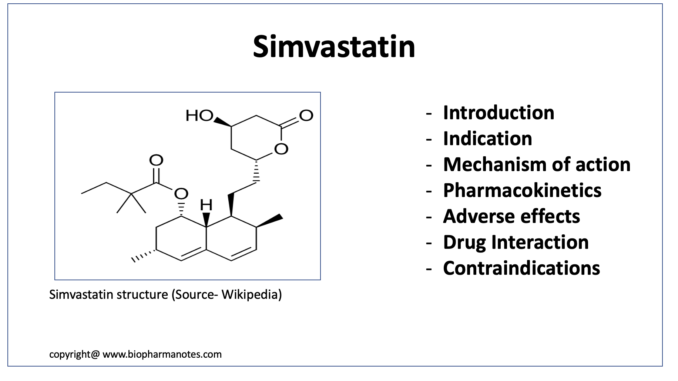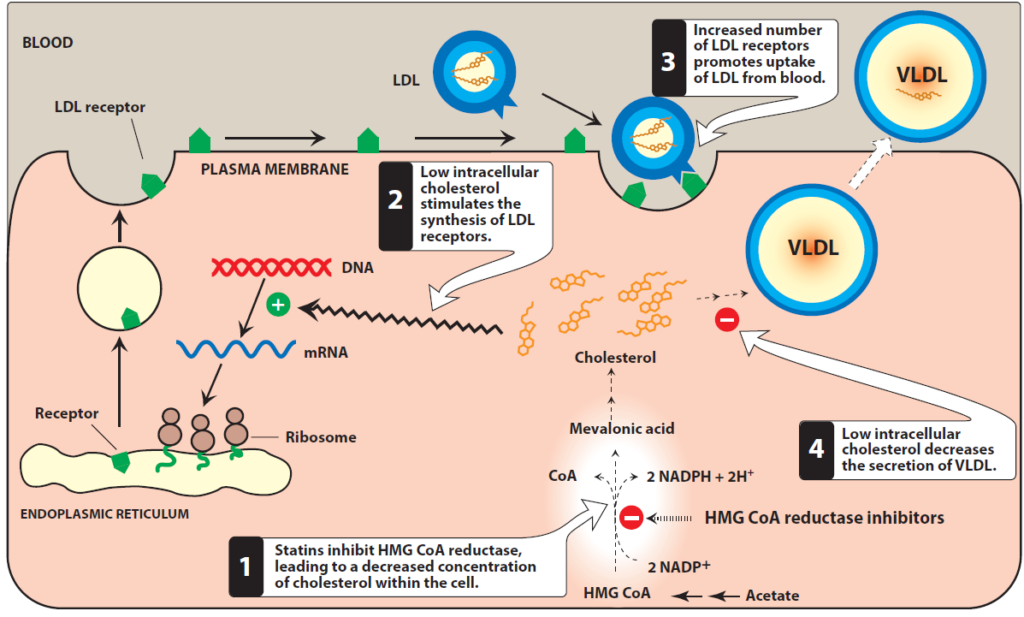
Simvastatin
- Simvastatin belongs to class of drug called HMG CoA reductase inhibitor or statins. Statins are lipid lowering agents and are among the most widely used drugs in cardiovascular pharmacology.
- It was first introduced in 1988. It is also available as generic medicine. Some other commonly used statins include pravastatin, atorvastatin, Fluvastatin and lovastatin etc.
- Simvastatin is obtained synthetically as fermentation product of Aspergillus terreus. It is available as combination product with cholesterol absorption inhibitor, ezetimibe.
Indications of simvastatin
- Used in treatment of primary hyperlipidemia (heterozygous familial and non-familial, Fredriskcon type IIa), hypertriglyceridemia, mixed dyslipidemia.
- In dysbetalipoproteinemia.
- To reduce adverse cardiovascular events like stroke, myocardial infarction.
- Some of its non-FDA approved uses include prophylaxis of atrial fibrillation in patients with stable coronary artery disease and prophylaxis of adverse cardiovascular outcomes post-acute-coronary syndrome hospitalization.
Mechanism of action of simvastatin

Figure 1- Inhibition of cholesterol synthesis by atorvastatin and other statins (Source- Lippincott’s Illustration of Pharmacology, 6th edition)
- Simvastatin is administered as prodrug. After its administration, its 6-membered lactone ring hydrolyzes to produce an active metabolite, beta-delta-dihydroxy acid. This active metabolite is a competitive inhibitor of HMG CoA reductase enzyme (Hydroxy Methyl Glutrayl Coenzyme A). HMG CoA reductase enzyme catalyze an early, rate-limiting step, conversion of HMG CoA to mevalonate, in cholesterol biosynthesis. Hence, it inhibits denovo synthesis of cholesterol and reduce internal supply of cholesterol.
- Simvastatin inhibits this rate limiting step everywhere, but most important site is in the liver. As the free cholesterol content within hepatocytes is reduced, synthesis of LDL receptor increases to bind and internalize circulating LDLs to extract cholesterol from them. The decrease in cholesterol synthesis and increase in catabolism of LDL leads finally in decreased plasma cholesterol level.
- Simvastatin also decreases triglyceride level and may increase HDL cholesterol level. It is also effective in reducing total cholesterol, LDL-C (low density lipoprotein cholesterol), apolipoprotein B and VLDL-C (very low-density lipoprotein- cholesterol). It also reduces IDL-C (Intermediate Density Lipoprotein Cholesterol) in patients with dysbetalipoproteinemia.
- When used in therapeutic dose, it doesn’t cause inhibition of all HMG CoA reductase enzyme. Hence, biologically required amount of mevalonate is still available in body.
Pharmacokinetics of simvastatin
- It is administered via oral route and is available as 5 mg, 10 mg, 20 mg, 40 mg and 80 mg tablets. Its dose may vary depending on the use. Both simvastatin and its active metabolite (beta-delta-dihydroxy acid) binds extensively to plasma proteins.
- Simvastatin undergoes extensive first pass metabolism in liver. CYP3A4 and CYP3A5 pathway plays major role in its metabolism. CYP2C8 and CYP2C9 also play role in remaining metabolism.
- Major portion of excretion of administered drug takes place via feces (around 60%) and remaining excretion takes place via urine.
Adverse effects
- Simvastatin, like other statins is well tolerated drug.
- The major adverse effects associated are myopathy which in severe condition can take the form of rhabdomyolysis and acute renal failure. Exact mechanism which causes myopathy is unknown. If drug is stopped immediately after myopathy symptoms are noticed, myopathy is reversible and acute renal failure may not occur.
Sometimes, patients may complain about myopathy which is not related to true statin induced myopathy. So, to confirm statin induced myopathy, blood sample should be tested for elevated level of CK (creatinine kinase).
- It can cause other side effects like abdominal pain, constipation, upper respiratory infection etc. Some other rare and severe side effects may include hepatic abnormalities, jaundice, cholestatic hepatitis, increased transaminase level etc.
Drug Interactions
- When simvastatin is used in combination with CYP3A4 inhibitors like erythromycin, cyclosporine, clarithromycin, protease inhibitors etc, these drugs may inhibit metabolism of simvastatin, increase its blood concentration. Hence, increase risk of myopathy.
- Fibrates and niacin, though doesn’t increase plasma concentration of simvastatin, can increase risk of simvastatin induced myopathy. Though this combination increases risk of myopathy, low dose of simvastatin is used in combination with niacin and fibrates as it is considered safe. When used together with these drugs, daily dose of simvastatin should not exceed 20 mg.
Contraindications/ Warning
- Contraindicated in patients with active liver disease and pre-elevated transaminase level.
- Contraindicated in pregnancy and in women who may become pregnant.
- Also contraindicated in breastfeeding women.
- Patient should be monitored before stating simvastatin therapy and also continuously monitored for liver function and transaminase level during simvastatin therapy.
References
- https://www.ncbi.nlm.nih.gov/books/NBK532919/
- https://go.drugbank.com/articles/A4869
- https://go.drugbank.com/drugs/DB00641
- https://journals.sagepub.com/doi/10.1177/106002809102500309
- https://www.ahajournals.org/doi/10.1161/01.cir.101.2.207
- Pederson TR etal. Simvastatin: a review. Expert Opin Pharmacother. 2004 Dec;5(12):2583-96.
- Pharmacology and Pharmacotherapeutics. 24th edition.
- Goodman and Gillman Manual of Pharmacology and Therapeutics.
- Lippincott Illustrated Reviews Pharmacology, 6th edition.